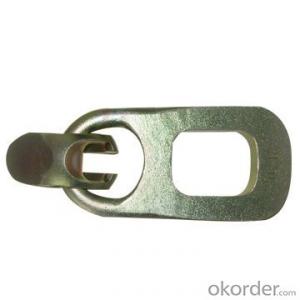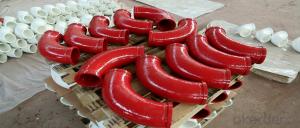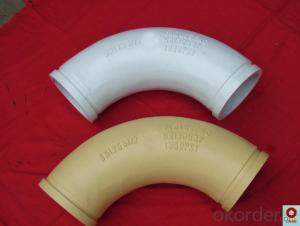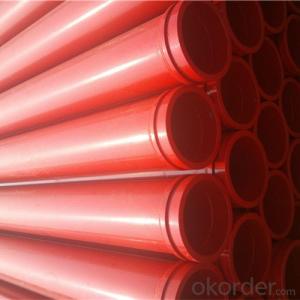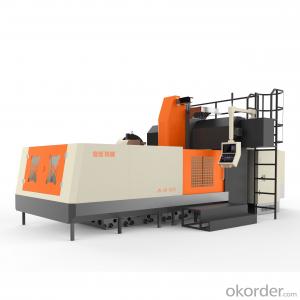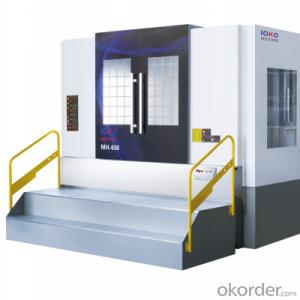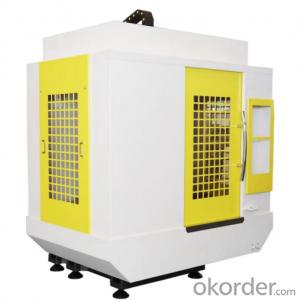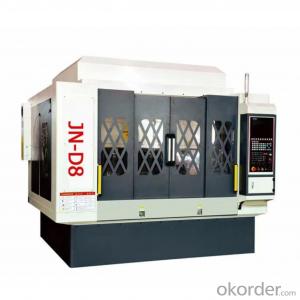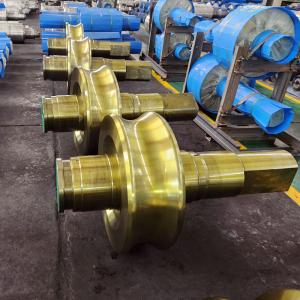Forged Concrete Ring Lifting Clutch with Hot-Dip Galvanized
- Loading Port:
- Tianjin
- Payment Terms:
- TT OR LC
- Min Order Qty:
- 100 pc
- Supply Capability:
- 10000 pc/month
OKorder Service Pledge
OKorder Financial Service
You Might Also Like
1. Materials: steel, hi tensile alloy steel, alloy steel, 20Mn2
2. Specification:
P-52 SL anchor
P-53 SL eye anchor
T - anchor
Eye anchor
3. Axial capacities load: 1.3T, 2.5T (2T), 5.0T (4T), 10.0T (8T), 20.0T, 32.0T
4. Primary competitive advantages:
1. More than 10 years focus on building material manufacturing
2. Prompt delivery time within 25 days after confirming order
3. Eathu's products are enhanced by the QA and quality control checks during the production, if necessary each order can be send out with a certificate referring back to test.
4. Precast concrete elements may be lifted several times after casting and during storage and erection-by using this system, the designer and the worker manager ensure that each lift is carried out safely and quickly.
5.Packaging and delivery:
Packaging details: goods packed in cartons and then on the pallet
Delivery detail: within 25 days after getting payment
· Experienced Staff
· Form A
· Guarantee/Warranty
· Packaging
· Price
· Product Features
· Product Performance
· Prompt Delivery
· Quality Approvals
· Reputation
· Service
· Small Orders Accepted
· More than 10 Years Experience
· Testing before shipping
Market:
Asia
Australasia
Central/South America
Mid East/Africa
North America
Western Europe
FAQ:
Q1: How long about delivery time Concrete Lifting Insert ?
A1: The delivery time will be very short, normally we keep the raw materials for old customers and sometime we also keep stock products to
make sure delivery time in any emergency cases.
Q2: How do we guarantee the quality of our Concrete lifting Insert ?
A2: We have established an advanced quality management system which conducts strict quality tests at every step, from raw materials to the final product. At the same time, we provide extensive follow-up service assurances as required.
Q3: How soon can we receive the product after purchase?
A3: Within three days of placing an order, we will book the vessel for goods. The specific shipping date is dependent upon international and government factors, but is typically 7 to 30 workdays.


- Q:How to judge the concrete pipeline blockage?
- When the conveying pressure increases gradually, while the material level of the hopper does not fall, the pipe outlet is not out of stock, the pump vibrates, and the pipe is accompanied by strong vibration and displacement, the pipe blockage can be determined.
- Q:How can a faulty pressure gauge affect the concrete pumping process?
- A faulty pressure gauge can have significant impact on the concrete pumping process. It can lead to inaccurate measurements of the pressure within the pump, which can result in improper monitoring and control of the pumping process. This can lead to over or under pressurization, affecting the flow and consistency of the concrete being pumped. Additionally, a faulty pressure gauge may not provide reliable readings, making it difficult to detect any potential issues or abnormalities in the pumping system, which can compromise the quality and integrity of the concrete being pumped.
- Q:How does a hopper agitator blade ensure smooth concrete flow?
- To guarantee a seamless flow of concrete, a hopper agitator blade is employed to mix and disintegrate any clumps or air pockets in the concrete mixture. Specifically designed to be positioned inside the hopper, the blade rotates and agitates the concrete, ensuring a homogeneous and steady state. While in rotation, the blade disperses any settled aggregates at the hopper's base, preventing blockages or uneven distribution during the pouring procedure. This uninterrupted mixing action guarantees that the concrete remains well-blended and effortlessly pours out of the hopper. Furthermore, the agitator blade aids in breaking up any air bubbles that may have formed within the concrete mixture. These air bubbles can compromise the structural integrity of the concrete and lead to an uneven final appearance. By agitating the concrete, the blade effectively releases trapped air, promoting a consistently dense mixture. In essence, a hopper agitator blade guarantees a seamless flow of concrete by effectively blending the mixture, breaking apart any clumps or air pockets, and fostering a uniform composition. This ensures that the concrete pours smoothly and evenly during the pouring process, resulting in a top-notch end product.
- Q:How often should hopper agitator shaft seals be replaced in a concrete pump?
- The replacement frequency of hopper agitator shaft seals in a concrete pump relies on various factors such as pump type, usage amount, operating conditions, and maintenance practices implemented. In general, it is recommended to regularly inspect hopper agitator shaft seals for any signs of wear, damage, or leakage. If any problems are detected, they should be promptly addressed to prevent further harm. However, as a rough estimate, these seals may require replacement every 6 to 12 months or after approximately 500 to 1,000 operating hours. It is important to understand that this is merely an approximation, and the actual replacement frequency may differ. The quality of the seals, intensity of usage, and operating conditions of the pump can significantly impact the lifespan of the seals. Furthermore, regular maintenance and appropriate lubrication can aid in extending the durability of the seals. To ensure optimal performance and prevent potential issues, it is advisable to consult the manufacturer's recommendations and guidelines specific to the concrete pump model being utilized. Adhering to their guidelines and conducting regular inspections of the seals will aid in determining the appropriate replacement interval for the hopper agitator shaft seals and guarantee efficient pump operation.
- Q:How often should hopper pins be inspected or replaced in a concrete pump?
- To guarantee the safe and efficient operation of concrete pump equipment, it is imperative to regularly inspect and replace hopper pins. The frequency of these inspections and replacements depends on various factors, including the concrete pump's usage and the condition of the hopper pins. As a general rule, it is advised to inspect hopper pins every three to six months or after every 400 to 600 hours of operation. However, it is crucial to note that this timeframe can differ depending on the intensity and volume of concrete pumping activities. During the inspection, it is necessary to carefully examine the hopper pins for any indications of wear, damage, or deformation. If any pins display significant signs of wear, such as cracks, elongation, or excessive corrosion, they should be promptly replaced to prevent potential accidents or equipment failure. Maintaining the structural integrity of the concrete pump and ensuring the safety of operators and the surrounding environment rely heavily on regular inspection and replacement of hopper pins. It is advisable to consult the manufacturer's guidelines or seek professional advice to determine the specific schedule for inspection and replacement, considering the make and model of the concrete pump.
- Q:Are there any safety considerations when using concrete pump spare parts?
- Concrete pump spare parts should be used with caution and with a focus on safety. High-quality parts that are compatible with the specific make and model of the pump are crucial. Using substandard or incorrect parts can lead to equipment failure, posing a danger to the operator and those nearby. Regular maintenance and inspection of the spare parts are also essential for safety. Checking for signs of wear or damage on a regular basis can help prevent accidents and equipment failure. It is vital to follow the manufacturer's guidelines for maintenance and replacement intervals. Adhering to safety procedures and protocols is a must when using concrete pump spare parts. This includes wearing appropriate personal protective equipment, such as safety goggles, gloves, and steel-toed boots. It is equally important to ensure that all operators receive proper training on equipment usage and understand the potential hazards involved. Safe operating practices are paramount when working with concrete pump spare parts. Maintaining a safe distance from the work area, ensuring the stability and security of the pump, and avoiding overloading or exceeding the recommended operating capacity are all crucial. By taking these safety considerations into account and following proper procedures, the risks associated with using concrete pump spare parts can be minimized. This ensures the safety of operators and workers on construction sites.
- Q:What are the different types of concrete pump pistons?
- In the construction industry, various concrete pump pistons are frequently utilized. These encompass the following: 1. Single-acting pistons: Smaller concrete pumps employ these pistons with a single working side. They propel the concrete out of the cylinder during the forward stroke and rely on gravity to retract the piston during the return stroke. 2. Double-acting pistons: Larger concrete pumps utilize these pistons with two working sides. They push the concrete out during the forward stroke and pull it back during the return stroke, thereby enhancing the pumping process's efficiency. 3. S-tube pistons: Trailer-mounted concrete pumps commonly employ these pistons, which are shaped like an S. They assist in regulating the concrete flow by directing it through a series of valves and pipes. 4. Rock valve pistons: These pistons are specifically designed for pumping concrete with larger aggregates. With their sturdy design, they can handle the more abrasive nature of such materials. 5. Gate valve pistons: These pistons employ a gate valve system to manage the concrete flow. They are frequently used in high-pressure applications and provide precise control over the pumped concrete's quantity. In summary, the selection of a concrete pump piston depends on various factors specific to the construction project, including the pump's size, the type of concrete being pumped, and the desired flow rate and pressure.
- Q:Can I get spare parts for concrete pump hydraulic systems?
- Yes, it is possible to get spare parts for concrete pump hydraulic systems. Many manufacturers and suppliers offer a wide range of spare parts specifically designed for concrete pump hydraulic systems. These spare parts can include components such as hydraulic cylinders, valves, hoses, filters, seals, and other essential parts. It is important to identify the specific make and model of the concrete pump hydraulic system to ensure compatibility when purchasing spare parts. Additionally, it is recommended to source spare parts from reputable suppliers or manufacturers to ensure quality and reliability.
- Q:How often should concrete pump gearboxes be inspected and maintained?
- To ensure optimal performance and a long lifespan, it is essential to regularly inspect and maintain concrete pump gearboxes. The frequency of these inspections and maintenance tasks depends on various factors, including the concrete pump's usage, working environment, and the manufacturer's recommendations. Typically, a comprehensive inspection and maintenance should be carried out at least once a year. However, if the concrete pump experiences heavy usage or operates in harsh conditions, more frequent inspections may be required, such as every six months or even quarterly. During these regular maintenance sessions, it is crucial to check for any signs of wear and tear, lubricate gears and bearings, and replace any worn-out or damaged parts. Adhering to the manufacturer's guidelines and seeking professional advice is important if there are any concerns or specific requirements for the concrete pump gearbox. By conducting regular inspections and maintenance, potential issues can be detected early on and promptly resolved, ensuring the smooth and efficient operation of the concrete pump gearboxes.
- Q:What are the different types of concrete pump clamps?
- There are several different types of concrete pump clamps, including snap clamps, bolt clamps, wedge clamps, and quick release clamps. These clamps are used to secure pipes and hoses in place and ensure a tight and secure connection during concrete pumping operations.
1. Manufacturer Overview |
|
|---|---|
| Location | |
| Year Established | |
| Annual Output Value | |
| Main Markets | |
| Company Certifications | |
2. Manufacturer Certificates |
|
|---|---|
| a) Certification Name | |
| Range | |
| Reference | |
| Validity Period | |
3. Manufacturer Capability |
|
|---|---|
| a)Trade Capacity | |
| Nearest Port | |
| Export Percentage | |
| No.of Employees in Trade Department | |
| Language Spoken: | |
| b)Factory Information | |
| Factory Size: | |
| No. of Production Lines | |
| Contract Manufacturing | |
| Product Price Range | |
Send your message to us
Forged Concrete Ring Lifting Clutch with Hot-Dip Galvanized
- Loading Port:
- Tianjin
- Payment Terms:
- TT OR LC
- Min Order Qty:
- 100 pc
- Supply Capability:
- 10000 pc/month
OKorder Service Pledge
OKorder Financial Service
Similar products
New products
Hot products
Hot Searches
Related keywords
